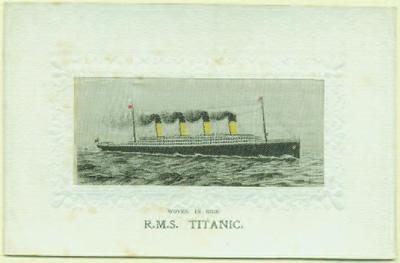Archives Clears the Deck for Titanic Exhibit
Campus News

This woven silk postcard is among the rarest Titanic artifacts. The only place known to sell these cards was the barbershop on board the ship.
By Mary Kate Skehan '12
Most of us know the story of the RMS Titanic and the famous disaster whose centennial will be observed on April 15. Fewer may know that RMS stands for Royal Mail Ship and that one of the Titanic’s primary responsibilities was postal delivery. Along with more than 1,500 people who perished in the tragedy, millions of undelivered mail items sank with the Titanic. Some postcards and other memorabilia that illustrate the catastrophe will be highlighted in the Archives & Special Collections’ latest exhibit, The Titanic and Cultural Memory: A Centennial Exhibit.
College Archivist Jim Gerencser ’93 notes that postcards reached peak popularity in the early 20th century, and many people at the time commemorated important personal or historic events by posting cards to family members. The maiden voyage of the “unsinkable” Titanic was no exception.
The exhibit, which opened March 19, began as a postcard collection in Reed Milbrath ’15’s family that has grown steadily over 40 years to more than 400 postcards. The family is lending it to archives in honor of three family members who attended Dickinson: Kathleen LeFevre ’21, Gladys B. LeFevre ’31 and Suzanne Horner Reed ’51. “Seeing all of the pieces that my family has collected over the years is something special,” Milbrath says. “People who have no idea about the Titanic can learn a little something from viewing the exhibit.”
Displayed in a series of glass cases, the exhibit reflects the scope of the Titanic’s story, explains Krista Gray ’09, Friends of the Library intern. Gray designed the exhibit to trace the ship’s story from its origins through its contemporary cultural legacy.
The theme of the first case is the vessel’s construction, furnishing and advertisement. The second case contains early memorabilia about the ship’s sinking. Gray notes that while some newspapers reported conservatively on the event, others printed erroneous stories of a miraculous rescue by a Halifax-bound ocean liner. Other memorabilia produced around the time of the sinking also illustrate the calamity.
A third case illustrates responses to the tragedy in the following months, and another pays homage to the past century of “cultural adoption” of the Titanic through memorabilia, film, artwork and even a musical.
The exhibit offers not only a broad, historical view of the tragedy, but also its human aspect. Part of the display will profile passengers, including Archibald Butt, military aide to President Taft, and Millvina Dean, the last living survivor (who died in 2009). Also noted is Thomas Mudd, a
16-year-old from Suffolk, England. Mudd posted a card to his mother before embarking on his journey to Chicago, but he perished in the disaster.
Many postcards and other artifacts escaped the tragedy when their owners disembarked in Ireland after one of the first legs of the ship’s journey. Among the surviving items is a woven silk postcard portraying the Titanic. The card is among the most rare and valuable cards for collectors, often described as the “crown jewel of any collection.” Milbrath notes that this piece is his personal favorite because of its rarity.
Though many pieces in the exhibit, like Mudd’s postcard, reflect the human loss and trauma of the Titanic, some were created as commemorations in decades following the disaster. There is a Titanic-themed cookbook, detailing the meals served on board; a ceramic bourbon bottle in the shape of the famous vessel, dating to the 1970s; and a poster of the 1997 Titanic film, signed by cast members.
Gerencser was most attracted to the collection because of its “human drama,” he says. “It seemed like something that had universal appeal. Disaster on that scale will always capture attention.”
Published June 14, 2013